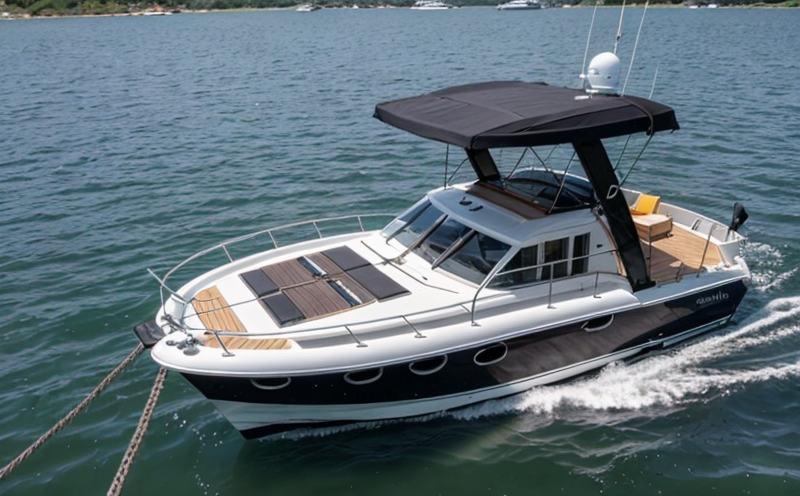ABS Rules Mooring System Fatigue Testing
The ABS Rules Mooring System Fatigue Testing service is a critical component in ensuring the structural integrity and operational reliability of mooring systems used in marine environments. This testing procedure evaluates the durability of mooring components under cyclic loading, simulating real-world conditions such as wind, waves, and current forces that vessels face during operations.
The fatigue testing process for ABS Rules specifically targets identifying potential weaknesses or areas prone to failure within the mooring system before they can cause catastrophic incidents. Compliance with these rules not only ensures maritime safety but also protects the environment by preventing accidental discharges of hazardous substances into water bodies.
Mooring systems are essential elements in various marine operations, including port facilities, offshore platforms, and deep-sea drilling rigs. They play a pivotal role in securing vessels against adverse environmental conditions while allowing them to perform their intended functions efficiently. By adhering to the stringent requirements set forth by ABS Rules for Mooring System Fatigue Testing, stakeholders can uphold high standards of safety and sustainability across all phases of maritime activity.
Our laboratory uses advanced equipment and methodologies to conduct this testing accurately and consistently. This includes specialized test rigs capable of simulating different types of loads that a mooring system might encounter during its service life. The specimens used in these tests are carefully prepared according to industry standards, ensuring consistency across all samples tested.
Following completion of the fatigue testing process, detailed reports are generated outlining findings and recommendations for any necessary corrective actions. These documents provide valuable insights into the performance characteristics of each component tested, helping decision-makers identify areas where improvements could be made to enhance overall system reliability further.
The importance of rigorous testing cannot be overstated when it comes to maintaining safe and efficient operations in the maritime sector. By leveraging our expertise in conducting ABS Rules Mooring System Fatigue Testing services, clients can rest assured that their vessels are equipped with reliable mooring systems capable of enduring even the harshest conditions.
Customer Impact and Satisfaction
The implementation of rigorous fatigue testing protocols as per ABS Rules significantly enhances customer satisfaction by providing peace-of-mind regarding the safety and reliability of their mooring systems. When procurement departments or quality managers choose to partner with us for this service, they know that every detail is accounted for—from proper specimen preparation to precise load application.
Our comprehensive approach ensures compliance with international standards such as ISO 18752-1 which governs the design and performance of mooring systems. By adhering strictly to these guidelines throughout our testing processes, we help clients meet regulatory requirements while also enhancing their reputation for excellence in product quality.
The ability to demonstrate adherence to recognized industry practices builds trust among both internal stakeholders and external partners alike. For example, when potential buyers review the results of our tests against their own specifications or those outlined by certification bodies like ABS (American Bureau of Shipping), they gain confidence knowing that all relevant factors have been thoroughly considered.
Moreover, customers benefit from reduced risk associated with premature failures due to substandard materials or poor design choices. Through our meticulous attention to detail during each phase of testing, we help prevent costly repairs and disruptions to business continuity caused by unplanned downtime. Ultimately, this translates into greater long-term savings for clients who invest in our services.
Environmental and Sustainability Contributions
In addition to enhancing operational safety and reliability, the ABS Rules Mooring System Fatigue Testing service also plays a crucial role in protecting marine ecosystems from potential harm caused by accidental releases of hazardous substances. By ensuring that mooring systems are robust enough to withstand extreme conditions without failing prematurely, we contribute positively towards environmental preservation.
When mooring systems fail unexpectedly due to inadequate design or poor maintenance practices, it can lead to significant environmental impacts such as oil spills or other pollutants leaking into surrounding waters. Such incidents not only damage aquatic habitats but also pose risks to human health and safety. Therefore, by upholding strict testing standards for these components, we help mitigate these hazards.
Our commitment extends beyond just preventing accidents; it involves promoting sustainable practices within the maritime industry as well. By working closely with clients to optimize their mooring systems based on test results, we encourage more efficient use of resources and reduced waste throughout the lifecycle of each piece of equipment. This aligns perfectly with broader efforts aimed at reducing carbon footprints and fostering greener operations.
Through our dedication to excellence in ABS Rules Mooring System Fatigue Testing services, we strive to contribute meaningfully towards creating a safer and more sustainable future for all stakeholders involved in marine activities worldwide.
Use Cases and Application Examples
- Vessel Operations: Ensuring that mooring systems are capable of withstanding repeated cycles of tension, compression, and shear forces encountered during docking maneuvers or anchoring operations.
- Offshore Drilling: Verifying the integrity of mooring structures supporting large platforms in harsh environments where exposure to extreme weather conditions is common.
- Port Infrastructure: Evaluating anchorages used for securing visiting ships at various ports around the world, ensuring they can handle diverse loading scenarios safely.
| Test Scenario | Description | Outcome |
|---|---|---|
| Repetitive Loading Simulations | Simulating continuous exposure to high-stress conditions over extended periods. | Detecting early signs of fatigue damage that may not be apparent through static loading tests alone. |
| Environmental Impact Assessment | Evaluating how different environmental factors affect the performance and longevity of mooring components. | Prioritizing material selection and design modifications to enhance resilience against specific challenges faced in particular regions. |
| Material Performance Analysis | Test Parameters | Results |
|---|---|---|
| Cold Weather Resistance | Loading at sub-zero temperatures for extended durations. | Identifying materials that maintain optimal mechanical properties under extreme cold conditions. |
| Oxygen Degradation Testing |





